Study of Surface Subsidence due to Underground Opening under Super-critical Condition Using Trap Door Apparatus
Main Article Content
Abstract
Physical model simulations have been performed to determine the effects of underground opening configurations on surface subsidence under super-critical conditions. This paper indicates the importance of the main factors that control the extent of surface subsidence and determines the effects of the geometry of underground openings on the angle of draw, the maximum subsidence and the volume of the subsidence trough. A trap door apparatus has been fabricated to perform the scaled-down simulations of surface subsidence. Gravel is used to represent the overburden in order to exhibit a cohesive frictional behavior. In plan view the excavation dimensions are sufficient to induce maximum possible subsidence. The findings can be used to evaluate the subsidence profile for tunnels and caverns in soft ground. The results show that the angle of draw and the maximum subsidence are controlled by the width (W), length (L), height (H) and depth (Z) of the underground openings. The width of the subsidence trough can be represented by the empirical relations. The relation between opening depth and subsidence trough developed by Rankin is in good agreement with the physical model results for deep openings (Z/W = 2, 3 and 4). For shallower openings (Z/W = 1), the predicted trough width is less than the physical model simulation. The volume of the subsidence trough is largest for Z/W = 2.5 and for H/W = 0.6, and is about 60% of the volume of the underlying opening.
Article Details
How to Cite
Thongprapha, T., Fuenkajorn, K., & Daemen, J. J. (2015). Study of Surface Subsidence due to Underground Opening under Super-critical Condition Using Trap Door Apparatus. Science & Technology Asia, 20(2), 53–62. retrieved from https://ph02.tci-thaijo.org/index.php/SciTechAsia/article/view/35790
Section
Engineering


